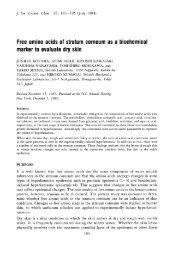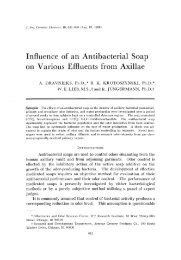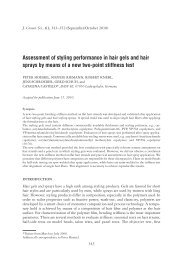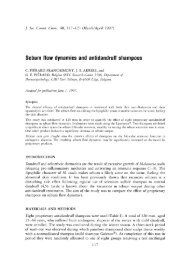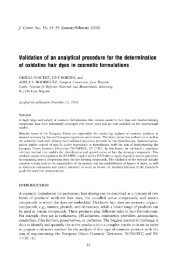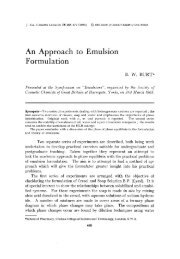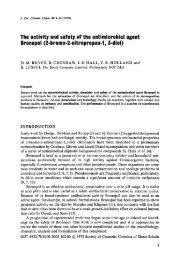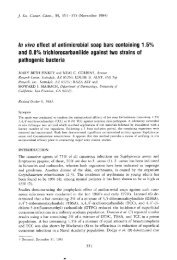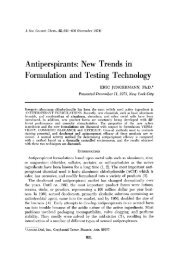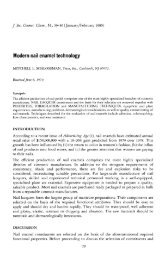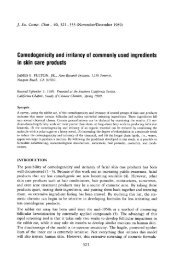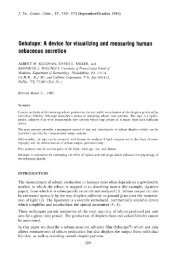A Critical Comparison of Two Procedures for Antiperspirant Evaluation
A Critical Comparison of Two Procedures for Antiperspirant Evaluation
A Critical Comparison of Two Procedures for Antiperspirant Evaluation
You also want an ePaper? Increase the reach of your titles
YUMPU automatically turns print PDFs into web optimized ePapers that Google loves.
270 JOURNAL OF THE SOCIETY OF COSMETIC CHEMISTS<br />
ANOVA<br />
Table VI<br />
<strong>of</strong> R'L Data <strong>of</strong> Table V<br />
(Method C)<br />
Source <strong>of</strong> Variation DF SS MS F<br />
Due to side treated i 0.0090 0.0090 0.106<br />
Error 10 0.8470 0.0847<br />
Total 11 0.'8560<br />
Most are very similar, but as can be seen, the difference increases<br />
a function<br />
<strong>of</strong> the disagreement between the two pretest ratios. In experiments in which<br />
more than two pretest ratios are used, or with larger sets <strong>of</strong> subjects, such substantial<br />
disagreements will be more numerous.<br />
4. Using the log-trans<strong>for</strong>med adjusted ratios R'L, carry out the ANOVA <strong>of</strong><br />
Table VI (separating "side treated" and error). This procedure is equivalent<br />
to doing a t-test <strong>for</strong> side treated (the square root <strong>of</strong> F is t in this case), but is<br />
done as a convenient method <strong>for</strong> obtaining an error estimate free <strong>of</strong> any sides<br />
effect.<br />
5. The standard error <strong>of</strong> the mean <strong>of</strong> the logs <strong>of</strong> the adjusted ratios is obtained<br />
from the ems in Table VI. Confidence limit are then calculated about<br />
the mean value <strong>of</strong> RL, antilogs taken, and the per cent reduction and its 95%<br />
confidence limits obtained.<br />
Sum•ry<br />
Mean <strong>of</strong> logs <strong>of</strong> adjusted ratios = R'L = --0.5097<br />
Standard error <strong>of</strong> mean = - 0.0840<br />
CLo.,• = R'•n --- S• to.o•<br />
= -0.507 _+(0.0840)(2.228)<br />
= -0.3226 to -0.6969<br />
to.o• at 10 df = 2.228<br />
antilog (-0.6969) = 0.498 (lower 95% CL <strong>for</strong> ratio)<br />
antilog (-0.5•7) = 0.601 (mean ratio)<br />
antilog (-0.3226) = 0.724 (upper 95% CL <strong>for</strong> ratio)<br />
PR• = (1-0.724)1• = 27.60 (lower 95% CL <strong>for</strong> PR)<br />
PR = (1-0.601)100 = 39.90 (mean per cent reduction)<br />
PRa= (1-0.498)100 = 50.20 (upper 95% CL <strong>for</strong> PR)<br />
Methods A, B, and C were applied to 5 sets <strong>of</strong> •o-sample antiperspirant<br />
data involving varying numbers <strong>of</strong> subjects, following the procedures just illustrated.<br />
The results are summarized in Table VII.



